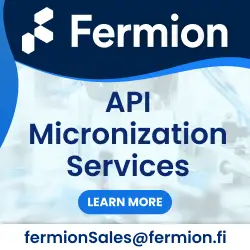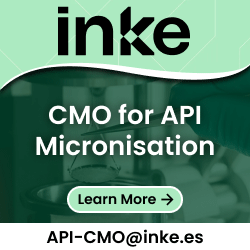Overview of micronization & milling contract services for APIs including nano-milling & jet-milling offered by leading pharma CDMOs & CMOs.
Q1. What is API micronization?
Micronization is a proven technology for reducing the particle size of active pharmaceutical ingredients (APIs) to increase the solubility and thereby the bioavailability of poorly soluble APIs.
Poor bioavailability is often a result of poor solubility. One way to enhance the solubility of a drug and increase its dissolution rate in the gastrointestinal tract is to reduce its particle size, which consequently increases its total surface area.
Within the pharmaceutical industry it is a widely accepted fact that, the finer the particle size of active pharmaceutical ingredients (APIs), the better the dissolution rate, which leads to faster absorption by the human body.
Therefore, particle size reduction plays a major role in designing different drug delivery systems, for example inhalers, sustained release (SR) formulations, etc.
Particle size reduction is accomplished through the micronization and milling of different particles in an air or nitrogen stream. Lager particles are retained in the mill by centrifugal forces while smaller particles are carried out of the mill and are collected in an explosive-resistant collector system.
Facilities equipped with state-of-the-air mills are able to provide the highest quality of micronisation to the pharmaceutical industry. Such micronisation is performed under cGMP conditions.
Demand is steadily growing for pharmaceutical materials that contain micronized active drug substances (APIs). Furthermore, active pharmaceutical ingredients (APIs) are micronized for a number of reasons, which are generally performance-related. The improvement in the physical properties of the APIs after micronization leads to optimization of the finished formulations.
The broad spectrum of advantages of the micronization of APIs are noted below:
- Uniformity of particle size
- Better solubility
- Improved bioavailability
- Improved appearance / brightness
- Increased surface area
- Time release engineering
Drug delivery systems deliver drugs at predetermined rates depending on the needs of the body over a specified period of time. Therefore, the process by which a drug leaves a drug product is called its drug release profile. Depending on the drug release profile, drugs may be classified into immediate release, modified release, delayed release, and extended release drug delivery systems, among several others.
- Co-micronization
Co-micronization, wherein an excipient is blended with an active pharmaceutical ingredient (API) prior to micronisation, results in a micronized drug product with decreased agglomeration between API particles (API agglomerate) potential, enhanced hydrophilic character and solubility, enhanced dissolution rate, and better flow properties.
Once micronization is complete, subsequent characterization of the micronized drug is also important to understand its bulk properties and further design downstream processes as well as contract manufacturing approaches.
Q2. What is the role of micronization in reducing the particle size of APIs?
Demand in pharmaceutical materials such as finely ground active substances and excipients is continuously growing. Some materials, injectable drugs and dry powder inhalants for instance, require particle sizes of APIs from 2-20 microns, with a minimum of fine and oversized particles.
Therefore, micronizing and nanosizing (nano-milling) technology for active pharmaceutical ingredients (APIs) has become an integral part of drug substance manufacturing services or API manufacturing services.
And with a variety of micronization techniques available to improve the delivery or solubility of poorly soluble APIs, precise control over particle size of APIs (particle size of active pharmaceutical ingredients) has become all the rage.
The micronization of APIs and highly potent APIs (HPAPIs) is increasingly becoming a key capability for Contract Development and Manufacturing Organizations (CDMOs) and pharmaceutical CMOs (contract manufacturing organizations) as demand for semi-solid drugs, creams and gels continues to grow, as well as the use of APIs in foodstuff ingredients increases.
All of these chemicals need to be micronized in order to increase their strength. Whether administered orally or topically (e.g. semi-solid drugs), solubility is a key factor in determining bioavailability, and ultimately, the effectiveness of different types of drugs including solid and semi-solid drugs, among others.
Micronization, which reduces particles down to the micrometer or, in some cases, nanometer size, can be used to improve the bioavailability of poorly soluble APIs by increasing particle surface area and accelerating dissolution rates. Micronization can also be used to improve formulation homogeneity and control the particle size of APIs.
Micronization’s Effects on Dissolution & Particle Size Distribution (PSD) of APIs:
- Surface Area and Dissolution
Creating a new surface area means adding energy that’s proportional to the bonds holding the particles together. Size reduction produces particles in a narrow size distribution range, and it’s easier to mix powders with narrow size ranges.
Moreover, one issue in the API or drug development process is the bioavailability of a compound, and one of the key factors affecting bioavailability is solubility. Reducing the size of the particle by increasing surface area improves the drug’s dissolution properties and can have a positive impact on the drug’s bioavailability.
- Particle Size Distribution (PSD)
Creating a narrow, homogenous average particle size distribution improves API uniformity, which can also enhance oral bioavailability. The particle size distribution also significantly affects powder flowability, bulk density, hygroscopicity, compatibility, porosity and blend uniformity.
PSD control is thus relevant for contract manufacturers of active pharmaceutical substances as it determines the performance of crystalline material and the efficiency of production operations such as filtration and drying or spray drying. Additionally, it also affects a material’s stability during storage.
Q3. What are the different micronization techniques?
Micronization can be performed with conventional micronization techniques (e.g. jet mill, bead mill) or via non conventional micronization techniques (e.g. Rapid Expansion of Supercritical Solutions (RESS) technology).
The properties of the micronized drug substance such as particle size, size distribution, shape, surface properties, agglomeration (API agglomerates) behaviour and powder flow are affected by the type of micronization technique used.
Some conventional and non-conventional micronization and milling techniques used in the pharma industry are explored in detail below:
Conventinal Milling
Milling involves the application of mechanical energy to physically break down coarse particles to finer ones and is regarded as a ‘top–down’ approach in the production of fine particles.
- Bead milling
A bead mill uses wet mechanical milling to obtain nano-size particles as small as 200–400 nm in what can be called micronization, or more accurately ‘nanonization or nano-milling’ because it refers to nanometer scale.
In an agitator bead mill, grinding beads and agitating elements are used to reduce the API particle size through impact, and because bead milling is a wet process, it avoids any problems related to dust.
Significant benefits to this style of milling include:
I. Milling and Micronization of APIs as Wet Substances
II. Dust-Free Micronzation and Milling
- Jet milling
Jet milling does not use mechanical components, but instead uses pressurized gas to create high particle velocity and high-energy impact between particles.
Compared with mechanical milling, jet milling reduces metal contamination and, because process temperature is relatively constant, can be used for heat-sensitive products. Jet milling, however, requires a deep understanding of the process and equipment used.
Furthermore, jet mills (or fluidized jet mills) are the preferred method of micronizing an API particle for use in an inhalation dosage form. The desired particle size is achieved by proper control of parameters.
Significant benefits to this style of milling include:
I. No Heat Build Up During Milling and Micronization
II. No Abrasion Generated Contamination
Non-Conventional Micronization Capability and Milling Techniques
Conventional micronization techniques may not be suitable for all drug substances. In the last few years, several supercritical fluid-based techniques have been proposed to produce micronized and nano-milling sized particles.
Three widespread processes used to produce fine and monodisperse powders include:
- Rapid Expansion of Supercritical Solutions (RESS) Technology: The rapid expansion of supercritical solutions (RESS) technology is a promising new technology for particle formation. The absence of liquid organic solvents, the mild processing temperatures, and the purity of the final product make this process particularly attractive for biomedical applications.
- Supercritical Anti Solvent (SAS): The Supercritical Anti Solvent (SAS) technique is a very flexible technique of micronization. It is based on putting an organic solution in contact with supercritical carbon dioxide, which ultimately leads to the production of completely solvent-free products. The advantage of the SAS process is that thermal degradation does not occur in the pharmaceutical compounds as the operating temperature is near room temperature.
- Particles from Gas-Saturated Solutions (PGSS): Particles from Gas Saturated Solutions (PGSS) is a technique for the production of microparticles of different materials of relatively low melting temperatures, such as polymers, waxes or fats. The process is based on the capacity of those materials to dissolve large amounts of CO2 at moderate pressures.
Q4. What are the challenges involved with API micronization techniques?
Micronization can be defined as a process of reducing the average diameter of solid particles, and micronization is thus used in solid dose manufacturing.
API micronization involves many challenges, risks and considerations. Some of the most common challenges associated with API micronization are explored in detail below.
API micronization Challenges:
- The initial particle size of API to be micronized, which plays a role in achieving the desired particle size, can be challenging for Contract Development and Manufacturing Organizations (CDMOs) and pharmaceutical CMOs (contract manufacturing organizations) offering API manufacturing services.
- Reducing particle size carries the risk of altering the morphology of the drug molecule, resulting in different polymorphs, amorphous APIs, or a mixture of crystalline and amorphous APIs.
- Micronized materials are charged and this may lead to segregation, clumping, and other possible physical instabilities during long term storage or in the formulation, if it is not well controlled.
- Micronization may result in agglomeration of API particles (API agglomerate). Particle segregation and agglomeration are the two major problems that could arise during blending of different size powders.
- Even though the micronization process offers advantages among other techniques, it has some limitations as it generates dust, the materials possess poor flow properties which create formulation processing problems.
- Selecting the appropriate technique for API micronization remains challenging. It is a complex process, reliant on an experienced team well-versed in the advantages and disadvantages of various drug micronization strategies.
Although micronization can be considered a rather consolidated technology, the interest in improving process control and optimization has increased in the past few years. CDMOs and CMOs are currently investing in developing new API micronization technologies and making advancements to existing technologies in order to overcome the challenges associated with API micronization.
Q5. Which are the different pharmaceutical companies offering API micronization services?
There are various Contract Development and Manufacturing Organizations (CDMOs) and pharmaceutical contract manufacturing organizations (CMOs) that offer API micronization services as well as spray drying, milling and other micronization services. Some leading pharmaceutical companies offering CDMO services with highly potent API and API micronization capabilities include:
High-Tech Ingredients Solutions (Hi-Tis)
Hi-Tis is dedicated to the micronization of active ingredients for the pharmaceutical, veterinary, food, cosmetic and nutraceutical industries. It has extensive experience in micronization and other solid treatments of active pharmaceutical ingredients (APIs).
Minakem
Minakem's key technologies include solid state characterisation, API particle size management, micronization, chiral chemistry, hazardous chemistry, flow chemistry, multi-step synthesis, etc.
Minakem has highly potent API and API manufacturing facilities and they offer a wide range of CDMO services including particle size distribution, particle size control, and micronization among other CDMO services.
Polpharma
Polpharma API has several years of experience in delivering APIs with the right particle size distribution through different methods such as crystallization, milling/micronization, vibration sieving or other technologies.
Jet Pharma
For more than 30 years Jetpharma has been successfully working in the field of micronization of active pharmaceutical ingredients (APIs)on behalf of third parties. Jetpharma is fully equipped for the micronization of highly active and cytotoxic ingredients.
Munit
Munit offers various services to the pharmaceutical industry including process development, milling, co-micronization, micronization under containment, post milling conditioning, cryogenic micronization, etc.
Bioindustria L.I.M. Spa
Bioindustria L.I.M. is highly competitive in providing drug substance manufacturing or API manufacturing services requiring high technology processes such as micronization.
FARMAK a.s.
FARMAK has an API manufacturing facility and utilize standard types of reactions with full cGMP manufacturing conditions, high-temperature reactions up to 300°C, low-pressure hydrogenation (up to 3bar), finalization of powder substances (sieving, grounding, micronization), etc. for the production of APIs and intermediates (pharmaceutical bulk intermediates).
ZCL Chemicals Ltd
ZCL Chemicals delivers a broad range of advanced fine chemicals, APIs and intermediates (pharmaceutical bulk intermediates) to the pharmaceutical industry. They have an API manufacturing facilityand multi-purpose cGMP manufacturing plants with micronizer air jet mill and multi-mill for particle size reduction.
All Suppliers
















 With Fermion, start the journey of your innovative API.
With Fermion, start the journey of your innovative API.














